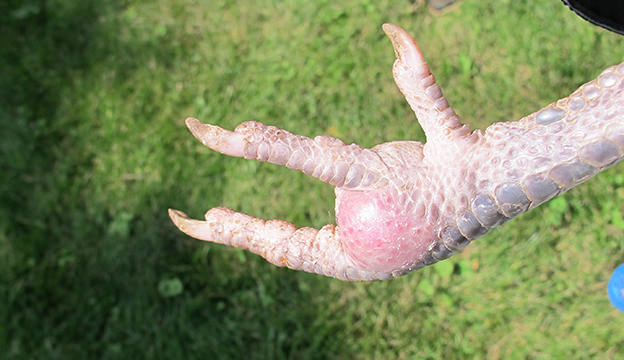When you do your frequent health checks of your poultry, look out for feet, claw and leg problems amongst your chickens. Lameness will prevent the fowls from leading a healthy and active life.
Generally, if any bird has been bred from healthy stock, was hatched with no incubator problems, is fed correctly and incurs no injuries it should remain clear of any leg problems. If an issue does arise it is usually easier to treat if caught early enough.
At the slightest hint that a bird is not comfortable on its legs, it should be thoroughly examined. Like all animals, chickens will try to cover up any weakness so as not to appear to be vulnerable to predators or to fellow members of the flock who might attack it.
What Can You See?
If you spot slight lameness the following need to be answered:
- Is the bird holding up the foot and clenching the toes?
- Are both legs lame or just one?
- Is there any swelling or heat in part of the leg that is lame?
- Are there any noticeable wounds?
- Is there muscle weakness in the leg or thigh?
- Is the bird using its wings to balance?
- Does the bird have any deformity in the legs or feet?
- Is the bird still eating and drinking?
- Is the bird showing an overall listlessness?
Staphylococcal infection, caused by S. aureus, is a major cause of lameness in chickens. Clinical signs of this disease include lameness, with swollen joints and foot pads. Staphylococcus aureus (Staph) is a common bacterium found in every poultry house. Stress or injury provides the opportunity this bacteria needs to enter the birds body and cause an infection.
What does Bumblefoot look like in chickens?
If there are no obvious injuries to the legs, examine the bottom of the foot. A cut on the pad or bottom of the foot can cause Staphylococcus bacteria to infect the foot and the pad to swell, causing lameness. Another name for this swollen pad is Bumblefoot. There may be pus in the swelling.

Since open injuries are the main route of entry, removal of all sharp edges within the chicken house and run is essential. If the birds brush by these edges, causing a small abrasion, infection is almost inevitable.
Sometimes the core of the wound can be removed and an antibiotic sprayed into the cavity. Antibiotics can be used in the feed or water, which may clear up the infection, but any damage to the feet and legs of the bird may be permanent.
More Bacterial Infections
If the hock joint and legs feel hot and look swollen or are painful to touch, the cause could be Mycoplasma synoviae, a bacterial infection which can sometimes be serious. It is best to visit your vet so that s/he may examine the bird and provide a course of antibiotics if appropriate.
If there is a bleeding wound on a leg or foot of your chicken, clean it with a mild antiseptic and then treated with wound powder or antibiotic spray. Bleeding needs to be stopped by applying sterile bandage or dressing. The chicken should be removed from the flock otherwise the others might peck at it.
Check daily to see if all the claws and toes are healthy so that you can treat damage immediately. If a claw has been broken through some mishap there will be evidence of blood on the bird’s perch. A broken toe may be bandaged to set it but if the break is too great it might require veterinary attention. Any open wound should be cleaned with a mild antiseptic and then treated with wound powder or antibiotic spray. The bird should then recuperate in an area with only clean shavings, which will mean picking up faeces whenever you check on it.
Marek’s Disease
Viral infections that might cause lameness are viral arthritis and Marek’s disease. Other symptoms of Marek’s disease are unilateral paralysis of the wing or leg, unthriftiness, grey eyes and blindness. Prevention entails vaccinating chickens on day one with virus vaccine. Unfortunately there is no treatment for the disease.
Scaly Leg
Scaly leg is a mite infestation of the shank and if left to deteriorate can eventually cause lameness. The mite burrows under the scales and it will cause irritation. This condition can be treated by dipping the legs in an acaricide or a pour-on treatment from the vet can be used. It is placed on the base of the neck and will be absorbed and then excreted by the skin, killing the mites from inside.

Curled Toe Paralysis
Curled toe paralysis is a condition that you might see in chicks if their feed has been low in vitamin B2. The toes frequently curl inward and they may be unable to stand. In early cases giving vitamin B2 in water leads to a rapid recovery. Consult your veterinarian on which one to use and dosage. Food sources of vitamin B2 include rapidly growing green leafy vegetables and forages, particularly alfalfa, eggs and organic beef liver. (The liver stores chemicals and toxins, so only use organic products.)
Maintain Good Nutrition
Nutrition is immensely important for building strong bones and muscle. If you do not provide the appropriate feed then there will be risk of leg problems as the birds grow.
Nutritional deficiency can lead to rickets, a result of deficiency in calcium, phosphorus and/or vitamin D3 or imbalances in the ratio of these nutrients. Chickens with rickets walk with difficulty and have soft bones and beaks.
To read more on poultry click here.
To subscribe to SA Smallholder click here.

